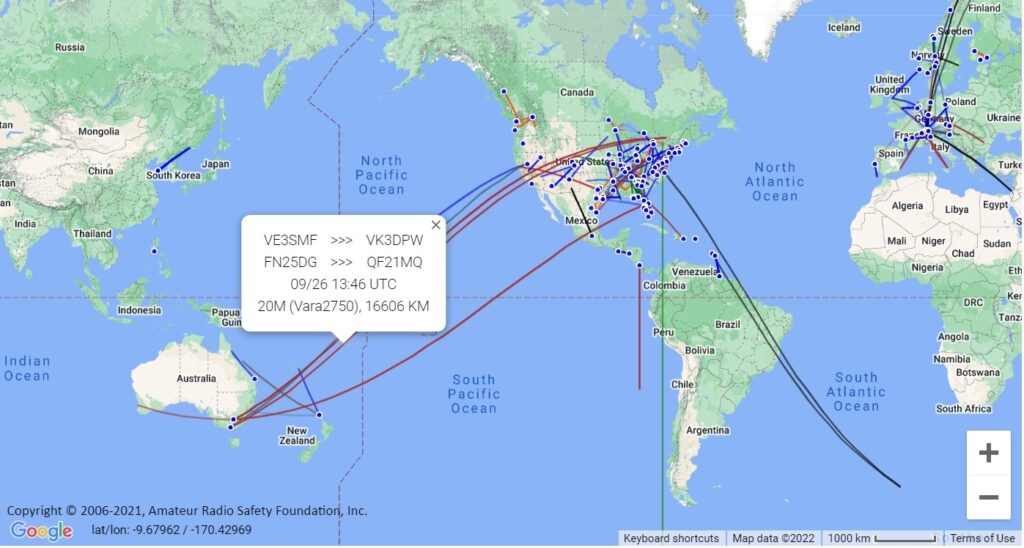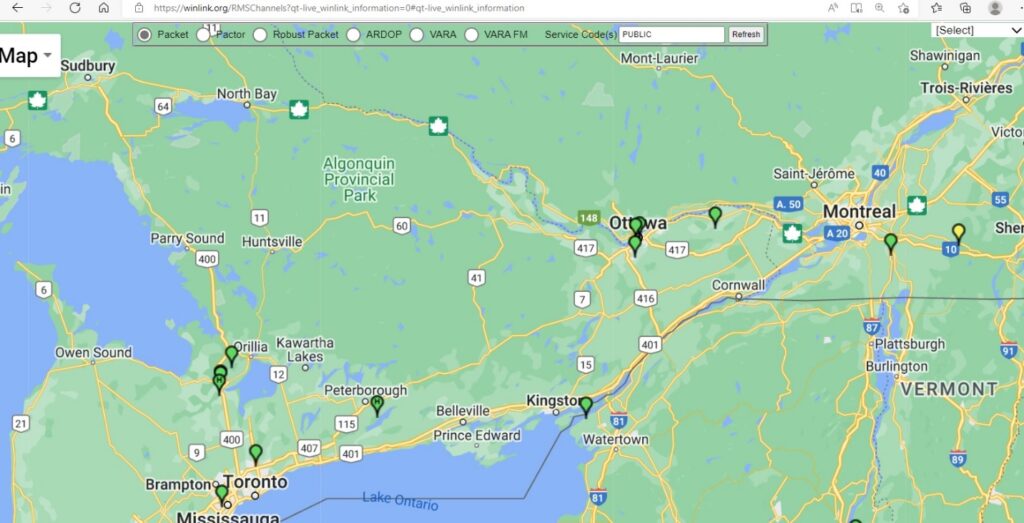Winlink Express (Winlink) (formerly RMS Express) is a radio client for email delivery with or without the internet. It is primarily used by amateur radio operators interested in Auxiliary Communications Service. It is becoming the preferred e-mail client for the RAC Auxiliary Communications Service (ACS).
The concept for Winlink Express, as designed and developed by the Winlink Development Team, was a radio-based e-mail system with maximum interoperability within the amateur radio systems. This radio-based system is compatible with access to the main Central Message System (CMS) using telnet (Internet) and using diverse amateur radio modes such as Telnet Winlink, Packet Winlink, Pactor Winlink, Robust Packet Winlink, Ardop Winlink, Vara HF Winlink, Vara FM Winlink, Iriudium GO Winlink, Packet P2P (Point-to-Point), Pactor P2P, Robust Packet (P2), Ardop P2P, Vara HF P2P, Vara FM P2P, Pactor Radio-only, Vara HF Radio-only, Vara FM Radio-only, Telnet Post Office. Besides using RF and Telnet modes, the system will also operate using MESH.
The magic happens with Winlink Express when messages are sent using the above modes that reach the main Central Message System (CMS) or the various HF/VUF/UHF Radio Message Server (RMS) gateway stations. The originating station can upload email messages using the above modes and the receiving station can download messages from an RMS gateway using the same or a different band, frequency and mode. This is truly the concept of amateur radio maximum interoperability.
I will now focus on Vara HF and Vara FM, which provide high data rates compared to traditional amateur radio modes.
VARA HF MODES
VARA HF sound modem has three operation modes: VARA HF Narrow (500Hz), VARA HF Standard (2300Hz) and VARA HF Tactical (2750Hz). VARA HF Tactical was designed for the military and other professional EMCOMM organizations which use Tactical HF Rigs for the operations. But it can also be used with some Ham rigs, mainly with the Icom IC-7300. VARA HF Standard is compatible with most Ham Radio HF rigs. VARA HF Narrow was designed for the digital bands limited to 500Hz bandwidth. It should be noted that amateur radio is an international community and that not all amateur radio operators have the same access to all the same modes band segments and bandwidths and frequencies.


Figure 2: VARA FM levels using VARA FM Wide and VARA FM Narrow. Note the differences in Symbol Rate, Carriers, Modulation, and Net Rate (bps). VARA FM will adjust the Net Rate (bps) as propagation conditions change. Both the sending and receiving stations will adjust to maximize data flow and reduce retransmissions of data.

Figure 3: The VARA HF graphical interface demonstrating a VARA HF connection with VE1YZ Gateway between Ottawa, ON and Halifax, NS using VARA HF Tactical at level 14, and data rate of 4830 bps. The graphical interface used on VARA HF and VARA FM permits the operator to visually see the data rates change during the data exchange process.

OK, enough of the theory of VARA HF and VARA FM. Lets move on to what this has to do with working DX. According to Wikipedia, DXing is the hobby of receiving and identifying distant radio or television signals, or making two-way radio contact with distant stations in amateur radio, citizens' band … other two-way radio communications. Many DXers also attempt to obtain written verifications of reception or contact, sometimes referred to as "QSLs". The name of the hobby comes from DX, telegraphic shorthand for "distance" or "distant".
Most of my operations using Winlink are 99% regional communications, passing e-mail traffic. Some times I use the Winlink HF Channel Selector to do various sorts of RMS Gateways based on <Call sign>, <Frequency>, <Mode>, <Grid Square>, <Distance>, <Bearing>, <Path Reliability Estimate> and <Path Quality Estimate> to build up my internal algorithm of propagation paths. This is really the only way to understand which RMS gateways have the highest probability of being accessed at any time of the day.


Figure 6: The VARA HF graphical interface demonstrating a VARA HF connection with HB9AK on 20 m band January 01, 2022. Note the VARA HF modem is at level (7) and 549 bps.

Figure 7: The Winlink.org live time RMS gateway mapdemonstrating a VARA HF connection of VE3SMF with HB9AK on 20 m band January 01, 2022 using VARA 2750 and a distance of 6093 Km. VE3SMF operation conditions: Transceiver ICOM IC-7300 running 50 watts into a three element HF beam at 50 ft.

Figure 8: Vara HF Channel Selector interface sorted by <Call Sign> to identify VK3DPW (Australia) on 14 MHz. Note that the Path Reliability Estimate and Path Quality Estimates are very poor.

Figure 9: The Winlink.org live time RMS gateway mapdemonstrating a VARA HF connection of VE3SMF with VK3DPW on 20 m band September 26, 2022 using VARA 2750 and a distance of 16606 Km. VE3SMF operation conditions: Transceiver ICOM IC-7300 running 50 watts into a three element HF beam at 50 ft.

Figure 10: Live Winlink System Information on Sunday 30-10-2022 of Packet RMS stations in the BC Vancouver area demonstrating the number of currently active Packet RMS gateways. The density of VHF Packet RMS gateways in the Canadian/USA border area and in the BC Interior should be noted. The major emergency services threats in BC and the USA area include earthquakes, tsunami surge, river floods, forest fires, political action, etc. The density of RMS Gateways in the costal areas reflects the relative risks.
Keep in mind that most maps such as the above are based on “Flat Earth” model, and the lines connecting from Ottawa to Australia are distorted. The path from VE3SMF in Ottawa was with a beam heading of 270 degrees (North) and would have gone over the polar region and then back South towards Australia. On that day, VK3DPW was the furthest Winlink RMS gateway from my location. I had expected this path to be open, based on grey-line DXing principles.
It should be noted that VARA HF and VARA FM were developed for high-speed data use and also for low signal strength use. In the low signal connections that I have made, the RMS gateway can be just at or below the noise level and these modes are still able to transfer small e-mails at low speed. As long as the message gets through, 100 % copy, life is good.

For further information on Winlink express please visit http://winlink.org and for Canadian information on the use of Winlink Express for the RAC Auxiliary Communications Service (ACS) please join the Canadian Winlink Operations Team whose goal is to facilitate training Canadian amateur radio operators in the use of Winlink Express to support local and regional mutual aid communications. main@RAC-ACS-Winlink-Net.groups.io | Home
If there is sufficient interest in the National Capital Region, I am willing to organize a series of Zoom Sessions aimed at the basic level required to Download the Winlink Express software, register your amateur radio call sign, and send/receive radio based messages. The expectations that I have are that participants be willing to install this software on a PC Windows based system (Windows 7 or higher) and be willing to troubleshoot their own hardware.
With sufficient interest, I will organize a weekly Winlink Wednesday net where stations send a message to the Net Control Station (NCS) in a formal net setting used by the local Auxiliary Communications Service.
Stuart Fedak VE3SMF
- Member of the Canadian Winlink Operations Team
- Administrator of the Canadian Winlink Operations Team site main@RAC-ACS-Winlink-Net.groups.io
- Sysop of the local Ottawa VHF RMS gateway that operates dual mode using Packet Winlink and VARA FM on 145.030 MHz.
Appears in: Rambler Vol. 65 Issue 3 November 2022
